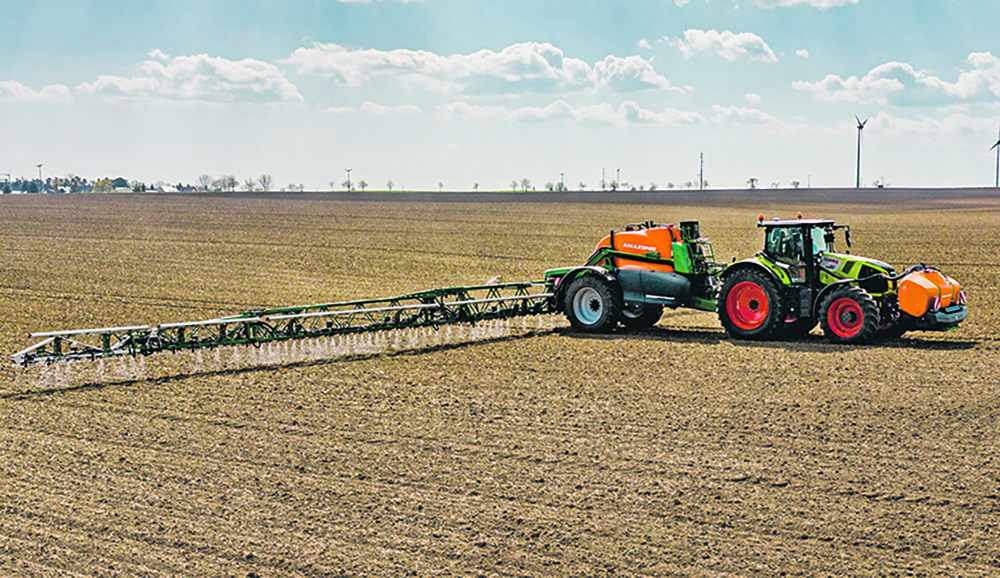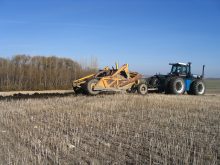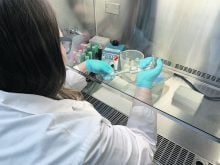Manufacturers are rolling out precision spraying systems to deliver reduced input costs and environmental impact
The ability to detect and manage individual plants in broad-acre production took big steps forward this year as multiple companies revealed green-on-green systems.
This production technique promises to be a significant defence to help farmers protect their business from future and current threats, including herbicide-resistant weeds – and scorn from consumer and environmental groups.
Green-on-green application systems locate and treat individual plants in crop, a much more difficult task compared to green-on-brown systems, which can detect and treat weeds for a burndown.
Green-on-brown systems typically use a light source on a sprayer boom. Then the near infrared light reflected by living chlorophyll in a plant gets detected by sensors mounted on the boom.
High resolution cameras and artificial-intelligence-based programs are required for green-on-green systems to identify in-crop weeds.
Several companies are looking hard at Canadian farms as a market for their selective application systems.
BASF Digital Farming launched its green-on-green system, dubbed Smart Spraying, in Brazil this winter.
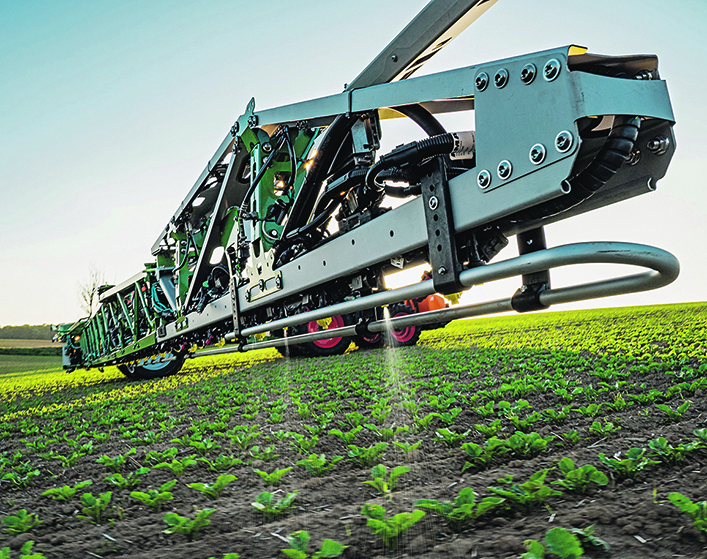
The company has been tweaking the system to work on United States fields and it will likely be commercially available in Canada within a few years.
Smart Spraying combines Bosch’s camera-sensor technology, boom-mounted lights and spraying hardware with BASF’s subsidiary Xarvio’s machine-learning-based platform that offers automated and real-time weed identification.
Jens Koenig of Bosch said the system will typically be set to detect plants as small as 10-by-10 millimetres in North America, while in Europe it will be set to detect plants as small as six-by-six mm.
In Europe, the cameras are set up to scan the field one metre in front of the boom while in North America they scan a metre and a half in front of the boom.
“We have seen that it’s useful to have different (image) resolutions from the ground. In Europe there are no GMO crops, or less GMO crops used, but in North America there are GMO crops,” Koenig said.
“You have different kinds of herbicides, different application strategies. Really high-resolution images are less useful (in North American crop production), but you want to drive faster, for example. So, we optimize the system for Northern America to the size of plants.”
There will also be some customizability of Smart Spraying.
“Depending on the weeds, if you have resistant weeds or weeds with a lot of seeds, which create a high seed bank for the next year, you would rather hit them all. Or if you have smaller weeds with low crop damage and the low multiplication potential, you could approach it differently,” Koenig said.
“If you want to optimize the performance or if you want to optimize savings and return on investment … it will be the farmer’s choice to select how we will help to set up the equipment.”
Users can change the sensitivity threshold by using Xarvio’s automated economic intelligence system.
This is done by logging onto a field manager account through a mobile app to set the desired performance level for a particular field.
Smart Spraying also enables the application of two products, a blanket and a spot spray, at the same time.
This is similar to a system developed by Greeneye Technology out of Israel, which can also apply two separate products with sprayers that have two product streams.
“You’ll see no adoption if you won’t enable farmers to have the ability to spray residual herbicides on a broadcast basis and non-residual herbicides precisely on the weeds. That’s exactly why we built our dual spraying system, to enable farmers to do exactly that,” said Nadav Bocher, chief executive officer of Greeneye Technology.
He said Greeneye can detect and spray weeds with 95.7 percent accuracy in corn and soy stands with a working speed of more than 20 kilometres per hour.
The system will be used to treat individual weeds in crops beyond soy and corn soon.
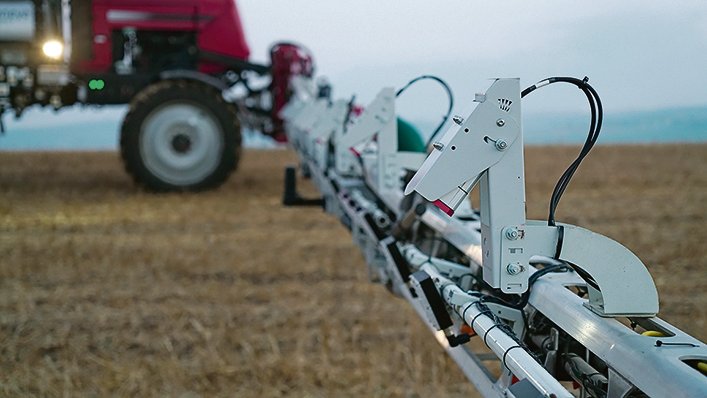
Greeneye recently opened an early adopter program for the 2022 growing season in Nebraska, Iowa and Illinois, which quickly sold out.
It is expected to be offered in more regions in 2023, including Canada.
Greeneye’s boom camera captures images at a rate of 40 frames per second, and this information is then used by Greeneye’s proprietary algorithms to calculate the location and amount of herbicide required to manage an individual weed.
The algorithms at the heart of Greeneye are unique data sets derived from millions of images from many different fields, crops, and growing regions including Canada, the United States and Australia.
Bocher lives in Quebec, and he said Greeneye has been collecting data from Canadian fields to train its algorithms for years.
This data set from Canadian fields may give Greeneye an advantage over competing green on green systems, because having localized weed datasets is the most formidable stumbling block faced by green-on-green system builders.
“Canada has been a huge centre as far as collecting data and training our algorithms for those very specific field conditions, which are very different from what you see in the states,” Bocher said.
“We have this huge library of just Canadian field corn, soybean, wheat and barley. That’s already done, and we are continuing doing it, and in the 2023 season we expect to offer the system for the Canadian market.”
Bocher said Greeneye can help producers reduce non-residual herbicide use by more than 78 percent.
“For farmers to actually adopt this technology, in many cases 90 percent accuracy (of in-crop weeds treated) is just not good enough because that means the 10 percent of the weeds will not be sprayed. That’s just a price a lot of farmers are just not willing to pay,” Bocher said.
“The average accuracy of our algorithms in real field conditions and commercial travel speed is 95.7 percent. The efficacy between Greeneye and broadcast spray is an almost identical performance when you use the same chemistry.”
A third company already angling for commercialization in the Canadian market is Bilberry, a start-up that uses technology developed for autonomous automobiles to help it develop a green-on-green application system.
“At that time (2015) it was really the beginning of artificial intelligence embedded in vehicles, in a very broad way. Before it was very difficult to solve all the technological challenges that exist for spot spraying. But with AI and the rise of embedded systems, really, we were at the right time to work on this and try to finish the solution,” said Guillaume Jourdain of Bilberry.
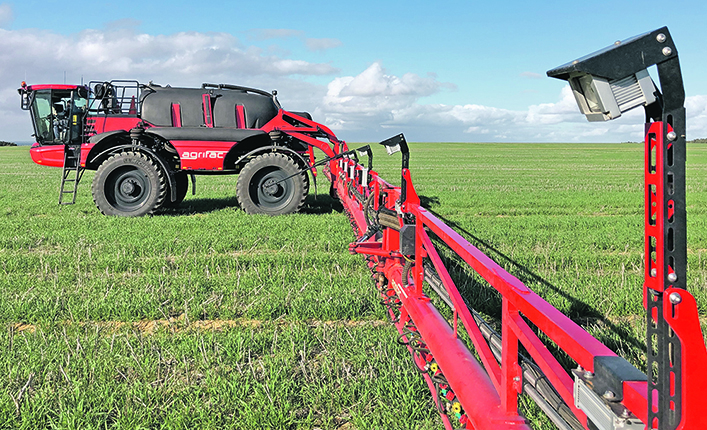
The Bilberry system has a camera every three metres on the boom. Each camera has a dedicated processor that sends the information to a central computer in the sprayer’s cab.
“From there we send the information to the nozzles to open them and close them in real-time, so individual nozzle control. Obviously, we are also linked to the GPS so we also have a section control that’s working,” Jourdain said.
“Normal speed for us (is) about 20 km-h. It can be a bit faster, but 20 (km-h) is where we are very comfortable.”
He said Bilberry’s spot spray system is effective at taking broadleaf weeds out of cereal crops, with a 90 percent average hit rate of the weeds while using a fraction of the chemical required for blanket applications.
The company continues to train its algorithms to improve its ability to differentiate different kinds of weeds in many crops including canola.
Bilberry is working with multiple spraying manufacturers including Agrifac, which is expanding into Canada, and it also has research projects underway including with Goldacres, an Australian manufacturer and supplier of agricultural spraying equipment.
Goldacres recently built a sprayer that uses Bilberry’s spot-spraying program and is towed by a SwarmFarm Robotics platform.
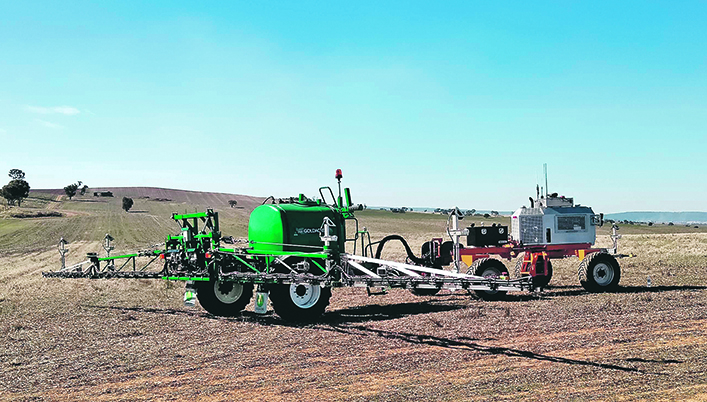
SwarmFarm, also Australian, produces a range of robots including Uniform, a fully autonomous unit powered by an 83 horsepower Hatz four-cylinder diesel engine that has a hydraulic drive with articulated steering and a top speed set to 10 km-h.
The Uniform robot tows the custom-built Goldacres sprayer, which is fit with a Raven controller and Bilberry’s spot-spraying system.
Jourdain said the Bilberry system works well with many kinds of equipment and cameras, and the company is focused on working to integrate its program with multiple equipment manufacturers.
Bilberry is commercially available in parts of Australia and is running trials in Europe, United States and Canada.
“Hopefully next year (2022) we can have, not a full commercial rollout, but we can have a few growers that can start using the technology,” Jourdain said.
Another interesting project beginning to cover Australian fields is the OpenWeedLocator (OWL), which is an open-source, low-cost image-based approach for fallow weed detection.
So far, the system is used for site specific weed control, either cultivation or spraying in fallow conditions.
However, one of the driving forces behind the project, Guy Coleman, said the plan is to expand the system to support green-on-green.
He said the OWL is an opportunity to redefine the approach to weed detection, by enabling community-driven technology development and implementation, because all the information about how it works is published.
“Using cheaper cameras and control boards really shifts things to detection and image analysis to get an actionable output, where you can plug in a spray solenoid to one of the relay boards, or use it to control a targeted tillage tool,” Coleman said.
He is a PhD Student at the University of Sydney and Fulbright Future Scholar currently based at Texas A&M University who researches artificial intelligence for weed recognition in large-scale production systems.

He recently wrote a twitter thread detailing the status of green-on-green technologies being developed around the globe.
He says other companies to watch include AutoWeed, Alterratech, John Deere/BlueRiver (which has a camera-based system called See and Spray for green-on-brown and is likely advancing the system towards green-on-green), DeepAgro and Carbon Bee. Swat Maps also got a nod for its automated Swatcam set to launch in 2022.
Coleman also lists drone-based green-on-green systems including Taranis Ag and Precision AI, as well as companies with working ground robotic systems capable of green-on-green weed detection including the Small Robot Company, Agerris, Carbon Robotics, Naio Technologies and Farm Wise.
A company called Exxact Robotics has also developed a green-on-green spot spraying system, and there are many more platforms that will begin to shift acres away from broadcast applications of crop protection products.
Once these green-on-green systems are deployed, there will be a big opportunity for further technological developments, because the high-resolution imagery these systems collect will have many uses beyond targeting weeds.
Algorithms could be developed in short order that could scour those images for signs of disease, pests, nutrient deficiencies, plant populations, and create high resolution weed maps to help producers choose the most effective crop protection products.
Guy Coleman’s Twitter thread on green-on-green tech is at bit.ly/3IVps4q.
robin.booker@producer.com


